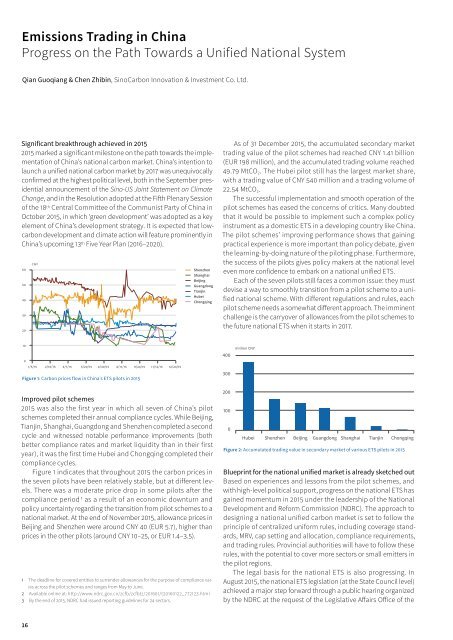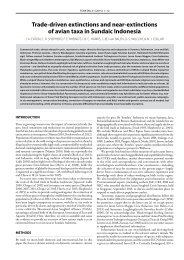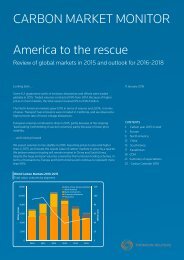Emissions Trading Worldwide
1TbjEHd
1TbjEHd
You also want an ePaper? Increase the reach of your titles
YUMPU automatically turns print PDFs into web optimized ePapers that Google loves.
<strong>Emissions</strong> <strong>Trading</strong> in China<br />
Progress on the Path Towards a Unified National System<br />
Qian Guoqiang & Chen Zhibin, SinoCarbon Innovation & Investment Co. Ltd.<br />
Significant breakthrough achieved in 2015<br />
2015 marked a significant milestone on the path towards the implementation<br />
of China’s national carbon market. China’s intention to<br />
launch a unified national carbon market by 2017 was unequivocally<br />
confirmed at the highest political level, both in the September presidential<br />
announcement of the Sino-US Joint Statement on Climate<br />
Change, and in the Resolution adopted at the Fifth Plenary Session<br />
of the 18 th Central Committee of the Communist Party of China in<br />
October 2015, in which ‘green development’ was adopted as a key<br />
element of China’s development strategy. It is expected that lowcarbon<br />
development and climate action will feature prominently in<br />
China’s upcoming 13 th Five Year Plan (2016–2020).<br />
60<br />
50<br />
40<br />
30<br />
20<br />
CNY<br />
Shenzhen<br />
Shanghai<br />
Beijing<br />
Guangdong<br />
Tianjin<br />
Hubei<br />
Chongqing<br />
As of 31 December 2015, the accumulated secondary market<br />
trading value of the pilot schemes had reached CNY 1.41 billion<br />
(EUR 198 million), and the accumulated trading volume reached<br />
49.79 MtCO 2 . The Hubei pilot still has the largest market share,<br />
with a trading value of CNY 540 million and a trading volume of<br />
22.54 MtCO 2 .<br />
The successful implementation and smooth operation of the<br />
pilot schemes has eased the concerns of critics. Many doubted<br />
that it would be possible to implement such a complex policy<br />
instrument as a domestic ETS in a developing country like China.<br />
The pilot schemes’ improving performance shows that gaining<br />
practical experience is more important than policy debate, given<br />
the learning-by-doing nature of the piloting phase. Furthermore,<br />
the success of the pilots gives policy makers at the national level<br />
even more confidence to embark on a national unified ETS.<br />
Each of the seven pilots still faces a common issue: they must<br />
devise a way to smoothly transition from a pilot scheme to a unified<br />
national scheme. With different regulations and rules, each<br />
pilot scheme needs a somewhat different approach. The imminent<br />
challenge is the carryover of allowances from the pilot schemes to<br />
the future national ETS when it starts in 2017.<br />
10<br />
0<br />
1/5/15 2/16/15 4/7/15 5/20/15 6/30/15 8/11/15 9/24/15 11/12/15 12/24/15<br />
Figure 1: Carbon prices flow in China’s ETS pilots in 2015<br />
400<br />
300<br />
million CNY<br />
Improved pilot schemes<br />
2015 was also the first year in which all seven of China’s pilot<br />
schemes completed their annual compliance cycles. While Beijing,<br />
Tianjin, Shanghai, Guangdong and Shenzhen completed a second<br />
cycle and witnessed notable performance improvements (both<br />
better compliance rates and market liquidity than in their first<br />
year), it was the first time Hubei and Chongqing completed their<br />
compliance cycles.<br />
Figure 1 indicates that throughout 2015 the carbon prices in<br />
the seven pilots have been relatively stable, but at different levels.<br />
There was a moderate price drop in some pilots after the<br />
compliance period 1 as a result of an economic downturn and<br />
policy uncertainty regarding the transition from pilot schemes to a<br />
national market. At the end of November 2015, allowance prices in<br />
Beijing and Shenzhen were around CNY 40 (EUR 5.7), higher than<br />
prices in the other pilots (around CNY 10–25, or EUR 1.4–3.5).<br />
1 The deadline for covered entities to surrender allowances for the purpose of compliance varies<br />
across the pilot schemes and ranges from May to June.<br />
2 Available online at: http://www.ndrc.gov.cn/zcfb/zcfbtz/201601/t20160122_772123.html<br />
3 By the end of 2015, NDRC had issued reporting guidelines for 24 sectors.<br />
200<br />
100<br />
0<br />
Hubei<br />
Shenzhen<br />
Beijing Guangdong Shanghai Tianjin Chongqing<br />
Figure 2: Accumulated trading value in secondary market of various ETS pilots in 2015<br />
Blueprint for the national unified market is already sketched out<br />
Based on experiences and lessons from the pilot schemes, and<br />
with high-level political support, progress on the national ETS has<br />
gained momentum in 2015 under the leadership of the National<br />
Development and Reform Commission (NDRC). The approach to<br />
designing a national unified carbon market is set to follow the<br />
principle of centralized uniform rules, including coverage standards,<br />
MRV, cap setting and allocation, compliance requirements,<br />
and trading rules. Provincial authorities will have to follow these<br />
rules, with the potential to cover more sectors or small emitters in<br />
the pilot regions.<br />
The legal basis for the national ETS is also progressing. In<br />
August 2015, the national ETS legislation (at the State Council level)<br />
achieved a major step forward through a public hearing organized<br />
by the NDRC at the request of the Legislative Affairs Office of the<br />
16




